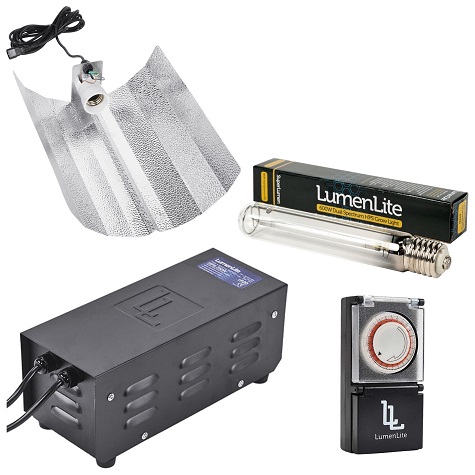
The information in this article can only be applied to “conventional” magnetic ballasts. Digital/electronic ballasts, which are becoming more common all the time, have some important differences regarding internal inspection, replacing parts, and matching bulb type to ballast. If your magnetic HID light system is giving you problems, you can follow a few basic steps to identify the problem.
Step One
Isolate the problem by checking on a few things. Is the ballast receiving electricity? If you plug the lamp in and hear humming noise, then it is a good bet that the ballast is working. If you do not hear humming noises check the plug and the outlet for a good connection. The next step is to check the transformer for burns; it is the large, dark steel box. If the transformer is burnt, then it must be replaced.
For HPS units you can also check the starter and the capacitor which look like an oblong tin can. The sealed lip around each end of the can should be completely smooth and have no wrinkles. If the ends are pinched out then the capacitor, the starter or both are burnt out and will need to be replaced.
Step Two
If you have verified the ballast is working, then the problem is probably with the bulb or the wiring. Check to ensure that the bulb is correctly and firmly screwed into the socket. This sounds simple but it is by far the most common reason for bulb failure. With the bulb in place check all the connections for heat and firm contact. Make sure the ballast is unplugged before touching any bare wires or connections. Inspect the arc tube inside the bulb. If it is dark, or if the bulb is over two years old, then it could be burnt out.
Step Three
If a fuse or breaker switch is thrown when you turn on the light, then the circuit is being overloaded. For safety reasons you should never use more than 80 percent of the amps available on a circuit. The amp rating should be printed on the breaker fuse.
Step Four
Do not worry if the lamp is flickering or pulsating. It takes approximately 100 hours of operation for the lamp halogens in the arc tube to stabilize and pulsate less. Color changes are also normal and do not affect the life or lumens of the bulb.
Step Five
Handle the bulbs gently and wipe off any fingerprints. Allow the bulb to cool for 15 minutes before restarting the lamp.
Facts about High Intensity Discharge Bulbs
- It is common for small pieces of glass or metal to be inside an HID bulb.
- The HID lamp must run with a ballast of the corresponding and type of bulb. For example, you should use a 1,000 watt Metal Halide ballast when you are using a 1,000 watt Metal Halide bulb.
- The light from the lamp will oscillate during the first few hours of use and decrease in intensity during the life of the lamp.
- The HID lamp takes approximately 3 minutes to warm up and reach 80% brightness. If the lamp is shut off after reaching full intensity it will take 10 – 20 minutes before it can restart.
- It is normal for the lamp to shift color during the first few hundred hours of use.
- HID lamps should be replaced after 12-18 months of use. The life span of the bulbs is dependent on how many times the lamp is turned on and off and frequent on-off cycles will shorten the life of the lamp.
Safety Information
- Do not look directly into the bulb during start up or operation.
- Turn the unit off immediately if the exterior glass of the light bulb cracks, punctures, or breaks. Ultraviolet radiation from the HID lamp can cause skin to burn or eye inflammation. They may still work but it should never be used in that condition.
- Inspect your bulb periodically for scratches and discard the bulb if scratches exist. Scratching the bulb or subjecting it to undue pressure could cause it to shatter.
- Use caution when watering foliage beneath lighting units and do not water foliage when the lights are on or have just been turned off. Functioning or recently functioning bulbs are hot and may shatter or crack if contacted by water.
- Never remove or insert the bulb while the power is on.
Background information for this article was provided by AHL Garden Supply.
Related Articles & Free Email Newsletter
5 Things to Consider Before Purchasing LED Grow Lights
A Beginners Guide to Grow Lights



Comment here